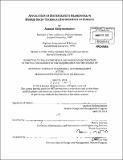| dc.contributor.advisor | Nancy Leveson. | en_US |
| dc.contributor.author | Abdymomunov, Azamat | en_US |
| dc.contributor.other | System Design and Management Program. | en_US |
| dc.coverage.spatial | me----- | en_US |
| dc.date.accessioned | 2012-05-15T21:13:01Z | |
| dc.date.available | 2012-05-15T21:13:01Z | |
| dc.date.copyright | 2011 | en_US |
| dc.date.issued | 2011 | en_US |
| dc.identifier.uri | http://hdl.handle.net/1721.1/70794 | |
| dc.description | Thesis (S.M. in Engineering and Management)--Massachusetts Institute of Technology, Engineering Systems Division, System Design and Management Program, 2011. | en_US |
| dc.description | Cataloged from PDF version of thesis. | en_US |
| dc.description | Includes bibliographical references (p. 91-93). | en_US |
| dc.description.abstract | The political transformation and transition of post-Soviet societies have led to hybrid structures in political, economic and technological domains. In such hybrid structures the roles of government, state enterprise, private business and civil society are not clearly defined. These roles shift depending on formal and informal interests, availability and competition for limited resources, direct and indirect financial benefits, internal and external agendas. In an abstract sense, a hybrid is "anything derived from heterogeneous sources, or composed of elements of different or incongruous kinds" (Hybrid). If transition is a process from one state to another, hybrid is a state unto itself. In the context of this thesis Hybrid Socio-Technical Environment means the co-existence of different institutions and policies, state and private business entities, old and new technologies, managerial models and practices of planning and market economies, collectivist and individualist value systems. Rapid technological progress, coupled with shifts in political and economic structures, may produce long-lasting disturbances in a society. Such disturbances are result of the hybrid society's contradictory nature. Some of these disturbances appear in the form of large-scale systemic accidents, such as the Sayano-Shushenskaya Hydroelectric Power Station accident. The rigid and outdated Soviet socio-technical system was broken down into multiple independent systems and subsystems to increase operational flexibility, with very limited capital investment. A twenty-year transition period (1990-2010), proved the survivability of the Soviet system, which was able to perform its primary functions even with partial capacity. However, recent large-scale accidents are clear signs that the system is stretching beyond its limits. Changes in the socio-technical landscape (multiple stakeholders and variety of interests) suggest that the traditional approaches of Reliability Theory, with its inward focus, may not be an effective tool in identifying emerging challenges. The outward-focused System theory approach takes into consideration key characteristics of the changing hybrid socio-technical landscape, as well as motivations of multiple stakeholders. The research concludes that insufficient capital investment and backlog in maintenance shifts are key systemic factors that allow migration of organizational behavior from a safe to an unsafe state. Additional analysis has to be conducted to prove this conclusion. | en_US |
| dc.description.statementofresponsibility | by Azamat Abdymomunov. | en_US |
| dc.format.extent | 93 p. | en_US |
| dc.language.iso | eng | en_US |
| dc.publisher | Massachusetts Institute of Technology | en_US |
| dc.rights | M.I.T. theses are protected by
copyright. They may be viewed from this source for any purpose, but
reproduction or distribution in any format is prohibited without written
permission. See provided URL for inquiries about permission. | en_US |
| dc.rights.uri | http://dspace.mit.edu/handle/1721.1/7582 | en_US |
| dc.subject | Engineering Systems Division. | en_US |
| dc.subject | System Design and Management Program. | en_US |
| dc.title | Application of system safety framework in hybrid socio-technical environment of Eurasia | en_US |
| dc.type | Thesis | en_US |
| dc.description.degree | S.M.in Engineering and Management | en_US |
| dc.contributor.department | System Design and Management Program. | en_US |
| dc.contributor.department | Massachusetts Institute of Technology. Engineering Systems Division | |
| dc.identifier.oclc | 792861134 | en_US |
